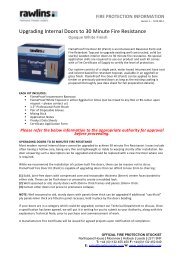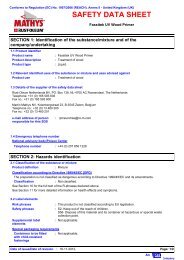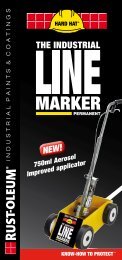SAFETY DATA SHEET - Rawlins Paints
SAFETY DATA SHEET - Rawlins Paints
SAFETY DATA SHEET - Rawlins Paints
Create successful ePaper yourself
Turn your PDF publications into a flip-book with our unique Google optimized e-Paper software.
7300 Combi-Color Finishes<br />
5.<br />
FIRE-FIGHTING MEASURES<br />
Extinguishing media : Recommended: alcohol-resistant foam, CO2, powders, water spray.<br />
Not to be used : water jet.<br />
Recommendations : Fire will produce dense black smoke. Exposure to decomposition products may cause a health<br />
hazard. Appropriate breathing apparatus may be required. Cool closed containers exposed to<br />
fire with water. Do not release runoff from fire to drains or watercourses.<br />
Hazardous combustion<br />
products<br />
6. ACCIDENTAL RELEASE MEASURES<br />
: Decomposition products may include the following materials:<br />
carbon dioxide<br />
carbon monoxide<br />
metal oxide/oxides<br />
Personal precautions : Exclude sources of ignition and ventilate the area. Avoid breathing vapor or mist. Refer to<br />
protective measures listed in sections 7 and 8.<br />
Spill : Contain and collect spillage with non-combustible, absorbent material e.g. sand, earth,<br />
vermiculite or diatomaceous earth and place in container for disposal according to local<br />
regulations (see section 13). Do not allow to enter drains or watercourses. Preferably clean<br />
with a detergent. Avoid using solvents. If the product contaminates lakes, rivers, or sewers,<br />
inform the appropriate authorities in accordance with local regulations.<br />
Note: see section 8 for personal protective equipment and section 13 for waste disposal.<br />
7.<br />
Handling<br />
Storage<br />
HANDLING AND STORAGE<br />
:<br />
:<br />
Vapors are heavier than air and may spread along floors. Vapors may form explosive mixtures<br />
with air. Prevent the creation of flammable or explosive concentrations of vapors in air and<br />
avoid vapor concentrations higher than the occupational exposure limits.<br />
In addition, the product should only be used in areas from which all naked lights and other<br />
sources of ignition have been excluded. Electrical equipment should be protected to the<br />
appropriate standard.<br />
Keep container tightly closed. Keep away from heat, sparks and flame. No sparking tools<br />
should be used.<br />
Avoid contact with skin and eyes. Avoid the inhalation of dust, particulates, spray or mist<br />
arising from the application of this preparation. Avoid inhalation of dust from sanding.<br />
Eating, drinking and smoking should be prohibited in areas where this material is handled,<br />
stored and processed. Workers should wash hands and face before eating, drinking and<br />
smoking.<br />
Put on appropriate personal protective equipment (see section 8).<br />
Comply with the health and safety at work laws.<br />
Store in accordance with local regulations. Observe label precautions. Do not store above the<br />
following temperature: 35°C (95°F). Store in a cool, well-ventilated area away from<br />
incompatible materials and ignition sources.<br />
Keep away from: oxidizing agents, strong alkalis, strong acids.<br />
No smoking. Prevent unauthorized access. Containers that have been opened must be<br />
carefully resealed and kept upright to prevent leakage.<br />
Do not empty into drains.<br />
8. EXPOSURE CONTROLS/PERSONAL PROTECTION<br />
Engineering measures : Provide adequate ventilation. Where reasonably practicable, this should be achieved by the<br />
use of local exhaust ventilation and good general extraction. If these are not sufficient to<br />
maintain concentrations of particulates and solvent vapors below the OEL, suitable respiratory<br />
protection must be worn.<br />
Ingredient name Occupational exposure limits<br />
naphtha (petroleum), hydrotreated heavy EH40/2005 WELs (United Kingdom (UK), 8/2007).<br />
STEL: 850 mg/m³, (as turpentine (150 ppm)) 15 minute(s). Form: Vapor<br />
TWA: 566 mg/m³, (as turpentine (100 ppm)) 8 hour(s). Form: Vapor<br />
1-methoxy-2-propanol EH40/2005 WELs (United Kingdom (UK), 8/2007). Absorbed through skin.<br />
STEL: 560 mg/m³ 15 minute(s).<br />
STEL: 150 ppm 15 minute(s).<br />
TWA: 375 mg/m³ 8 hour(s).<br />
TWA: 100 ppm 8 hour(s).<br />
Exposure controls/personal protection<br />
Date of issue/Date of<br />
revision<br />
: 06-04-2010. Page: 2/6






